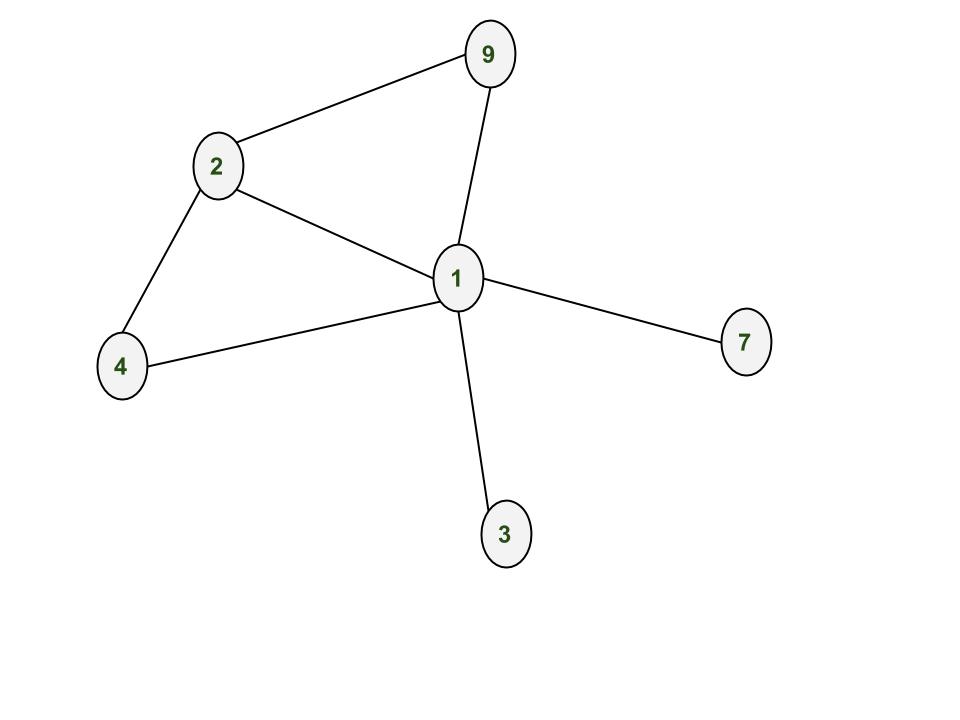NetworkX : Python software package for study of complex networks
Last Updated :
11 Jul, 2022
NetworkX is a Python language software package for the creation, manipulation, and study of the structure, dynamics, and function of complex networks. It is used to study large complex networks represented in form of graphs with nodes and edges. Using networkx we can load and store complex networks. We can generate many types of random and classic networks, analyze network structure, build network models, design new network algorithms and draw networks.
Installation of the package:
pip install networkx
Creating Nodes
Add one node at a time:
G.add_node(1)
Add a list of nodes:
G.add_nodes_from([2,3])
Let us create nodes in the graph G. After adding nodes 1, 2, 3, 4, 7, 9

Creating Edges:
Adding one edge at a time:
G.add_edge(1,2)
G.add_edge(3,1)
G.add_edge(2,4)
G.add_edge(4,1)
G.add_edge(9,1)
Adding a list of edges:
G.add_edges_from([(1,2),(1,3)])
After adding edges (1,2), (3,1), (2,4), (4,1), (9,1), (1,7), (2,9)

Removing Nodes and Edges:
One can demolish the graph using any of these functions:
Graph.remove_node(), Graph.remove_nodes_from(),
Graph.remove_edge() and Graph.remove_edges_from()
After removing node 3

After removing edge (1,2)

Python3
import networkx
G = networkx.Graph()
G.add_node(1)
G.add_node(2)
G.add_node(3)
G.add_node(4)
G.add_node(7)
G.add_node(9)
G.add_edge(1,2)
G.add_edge(3,1)
G.add_edge(2,4)
G.add_edge(4,1)
G.add_edge(9,1)
G.add_edge(1,7)
G.add_edge(2,9)
node_list = G.nodes()
print("#1")
print(node_list)
edge_list = G.edges()
print("#2")
print(edge_list)
G.remove_node(3)
node_list = G.nodes()
print("#3")
print(node_list)
G.remove_edge(1,2)
edge_list = G.edges()
print("#4")
print(edge_list)
n = G.number_of_nodes()
print("#5")
print(n)
m = G.number_of_edges()
print("#6")
print(m)
d = G.degree(2)
print("#7")
print(d)
neighbor_list = G.neighbors(2)
print("#8")
print(neighbor_list)
G.clear()
|
Output:
#1
[1, 2, 3, 4, 7, 9]
#2
[(1, 9), (1, 2), (1, 3), (1, 4), (1, 7), (2, 4), (2, 9)]
#3
[1, 2, 4, 7, 9]
#4
[(1, 9), (1, 4), (1, 7), (2, 4), (2, 9)]
#5
5
#6
5
#7
2
#8
[4, 9]
In the next post, we’ll be discussing how to create weighted graphs, directed graphs, multi graphs. How to draw graphs. In later posts we’ll see how to use inbuilt functions like Depth first search aka dfs, breadth first search aka BFS, dijkstra’s shortest path algorithm.
Like Article
Suggest improvement
Share your thoughts in the comments
Please Login to comment...